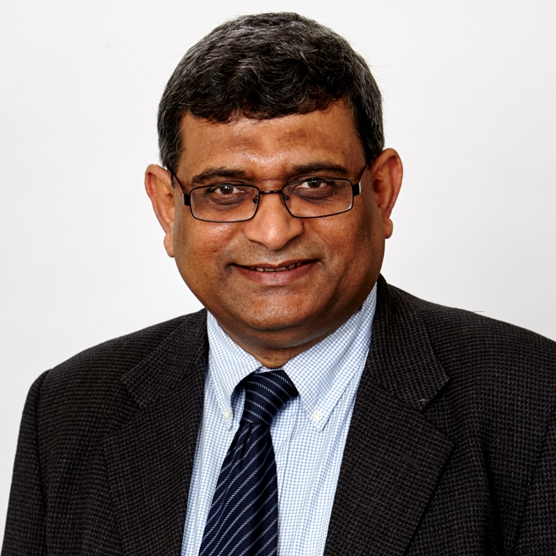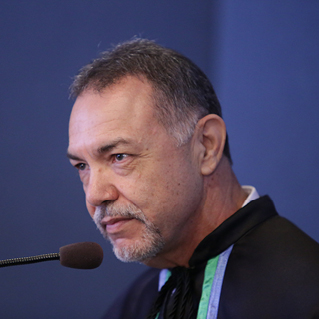
Title: 2D Heterostructures & 2D Ferroelectrics
Plenary Speaker
Prof. Andrew T. S. Wee
Department of Physics, National University of Singapore, Singapore
Abstract
I will talk about two of our recent projects on 2D materials. First, we report a phase-selective inplane heteroepitaxial method to grow semiconducting H-phase CrSe2 (Nat. Comm. 2024). The lattice-matched MoSe2 nanoribbons are utilized as the in-plane heteroepitaxial template to seed the growth of H-phase CrSe2 with the formation of MoSe2- CrSe2 heterostructures. Scanning tunneling microscopy and non-contact atomic force microscopy studies reveal the atomically sharp heterostructure interfaces and the characteristic defects of mirror twin boundaries emerging in the H-phase CrSe2 monolayers. Second, I will, report the observation of a single-element ferroelectric state in a black phosphorus-like bismuth layer, in which the ordered charge transfer and the regular atom distortion between sublattices happen simultaneously. Instead of a homogenous orbital configuration that ordinarily occurs in elementary substances, we found the Bi atoms in a black phosphorous-like Bi monolayer maintain a weak and anisotropic sp orbital hybridization, giving rise to the inversion-symmetry-broken buckled structure accompanied with charge redistribution in the unit cell. As a result, the in-plane electric polarization emerges in the Bi monolayer. Using the in-plane electric field produced by scanning probe microscopy, ferroelectric switching is further visualized experimentally. Owing to the conjugative locking between the charge transfer and atom displacement, we also observe the anomalous electric potential profile at the 180° tail-to-tail domain wall induced by competition between the electronic structure and electric polarization
Biography
Andrew Wee is a Class of ’62 Professor of Physics at the National University of Singapore (NUS), He was previously Dean of Science and Vice President (University and Global Relations). His research interests are in surface and nanoscale science, scanning tunneling microscopy (STM) and synchrotron radiation studies of the molecule-substrate interface, graphene and related 2D materials. He was a Commonwealth Fellow as well as a Rhodes Scholar at the University of Oxford, where he received his received his DPhil (1990). He holds a Bachelor of Arts (Honours) in Physics (1994) as well as a Masters degree from the University of Cambridge. He serves or has served on several journal editorial boards

Title: The Dire Consequences of Nano Tech Development and Transhumanism Morphology
Keynote Speaker
Bryan Pelletier
Bryan396 Nano Tech Research Project, Canada
Abstract
My presentation will provide multiple examples of the nanotechnology self assembling polymers, nanotechnology programmable magnetic carbon and nano tech components that have saturated the human body, making it a biotech frequency transceiver and computer network. This is creating an alteration of our DNA and genetics, the result of MRNA genetic transfers and DNA attachments. All life on the planet is at a critical stage of nano tech saturation, permanent genetic mutating and biological alterations.
In 2012, during research, I encountered a controversial condition termed Morgellons, that appeared to be the same as those that the nano tech developers were displaying in their lab reports.
In comparing the images of the Morgellons with the Nano Tech researchers published achievements, I saw them as being similar and when observing them under microscope, concluded that these were bio nano tech assemblies and components.
My investigations found these to be consistent with the samples taken from the research papers on nano tech, the morgellons sample pictures and the ones i have found in the human body, and documented.of pictures and explanatory videos.
The removal of these nano nodes has reversed many lifelong health issues, some had repeated medical interventions, thus improving health and vitality.
There is an expected response, of auto rejection, at these findings, and these will disperse as the findings are reviewed and analyzed.
Any hesitation of accepting the information as factual and accurate, will dissipate as the extensive documentation is reviewed.
My 12 years of focused research has logged 10's of thousands of research hours, along with deep reflective analytical contemplation and personal observations, to arrive at these findings and conclusions.
What I have found,and offer evidence of, is substantiating and indisputable proof of the claims I am making about the genetic disruptions, along with an explanation and understanding of what processes are involved.
My discoveries have traced the nano tech loading, of life long loading, back to childhood medical issues, as they reappeared and were removed.
The lifelong accumulation of the nano materials, which is responsible for many health, if not all health issues, we are now experiencing from the nano tech loads, that have manifested as unusual new outbreaks of diseases. .
My claims are easily verifiable by anyone who takes the time to inspect their own bodies with an inexpensive USB microscope, available on the internet for $30.
One can easily identify the red and blue colored threads that are embedded in the polymer hydrogel layers that coat the body and shrink with a high volume of water evaporation, from the hydrogels on the tissue surfaces, at a magnification of 200x.
There are ample documents that they have published claiming to use the nano tech in geo engineering, in agriculture and meat production.
I will be assembling a detailed overview of each stage of the nano build processes, as soon as possible, and prior to the conference for reference and to provide a foundation to work from
Biography
Xerox Computer Tech last half of the 1980's Home Contractor and Caretaker for the money privileged in the early to mid 90's Mid 90's til 2004 Motivated by a Mid life health crisis, started my deep spiritual studies of the Metaphysical Realms, Miracles Manifested, Quantum Physics, Medical Investigations and many obscured teachings and understandings from ancient and obscure texts that have faded from public knowledge and hidden overtime. 2004 til 2012 I Started a Far Infrared Massage Bed, and subtle body energy systems, Health Clinic, with a Chinese partner who was well versed in acupuncture and Chinese healing techniques. I continued Spiritual Studies with Body and Mine Energy and Control System, related to frequencies and alternate healing modalities detached from main stream alopathic protocols and belief systems. 2010 Published Zero Point Energy Document on Frequencies and Manifestation, 2011 Discovered the bio nano load in the body and saw it as Self Assembling Polymers. Produced the initial Nano Tech Document. ' Chemtrails Morgellons', Self Assembling Polymers and Nano Technology.' 2011 til 2020 Nano Tech Research and Experiment. 2020 Formulation of the Ionic Formulas and Compounds 2020-2023 Continued formulation and testing of effective nano tech neutralization and detoxification. Currently: Ongoing testing of the formulas and tweaking the process and continuing research, now dedicated to nano tech research and public awareness for the last 12 yrs.@ 12 - 18 hrs daily, with over 100,000 Hrs. of research time invested.

Title: Circumventing Challenges in CVD Graphene Coating on Mild Steels for Remarkable and Durable Corrosion Resistance
Plenary Speaker
Prof. Raman Singh
Department of Mechanical & Aerospace Engineering, Department of Chemical & Biological Engineering, Monash University, Vic 3800, Australia
Abstract
Graphene has triggered unprecedented research excitement for its exceptional characteristics. The most relevant properties of graphene as corrosion resistance barrier are its remarkable chemical inertness and impermeability and toughness, i.e., the requirements of an ideal surface barrier coating for corrosion resistance, thus, an interest in graphene coating as a disruptive approach to corrosion mitigation. However, the extent of corrosion resistance due to chemical vapour deposition (CVD) graphene coatings has been found to vary considerably in different studies. The author’s group demonstrated the ultra-thin graphene coatings developed on copper and nickel by CVD to improve corrosion resistance of the metals by two orders of magnitude in aggressive aqueous chloride environments. In contrast, other reports suggest the graphene coating to actually enhance corrosion rate of copper, particularly during extended exposures. Author’s group has investigated the reasons for such contrast in corrosion resistance due to graphene coating as reported by different researchers, and on the basis of the findings, they have succeeded in developing multilayer graphene coatings that conferred durable corrosion resistance to copper and nickel in the aggressive chloride environment.
Corrosion and its mitigation costs dearly (any developed economy loses 3-4% of GDP due to corrosion, which translates to ~$250b to annual loss USA). In spite of traditional approaches of corrosion mitigation (e.g., use of corrosion resistance alloys such as stainless steels and polymeric coatings), loss of infrastructure due to corrosion continues to be a vexing problem. Therefore, it is technologically as well as commercially attractive to explore graphene coating as a disruptive approach to durable corrosion mitigation. However, developing graphene coating on the most common engineering alloy, mild steel by CVD is a non-trivial challenge. The presentation will discuss the challenges, and their successful circumvention that enabled graphene coatings on mild steel, and presents results demonstrating durable and remarkable corrosion resistance of graphene-coated mild steel
Biography
Professor Raman Singh’s primary research interests are in the relationship of Nano/microstructure and Environment-assisted degradation and fracture of metallic and composite materials, and Nanotechnology for Advanced Mitigation of such as graphene coatings. He is a senior professor at Monash University, Australia. He is/was a Guest Professor at ETH Zurich, Switzerland (2020, 2023, 2024), US Naval Research Lab, Indian Institute of Science, and University of Connecticut. He worked as a scientist at Indian Atomic Energy and as a post-doc fellow at UNSW/Australia. His professional distinctions and recognitions include: Guest Professor of ETH Zurich, Editor of a book on Cracking of Welds (CRC Press), Lead Editor of a book on Non-destructive Evaluation of Corrosion (Wiley), Editor-in-Chief of an Elsevier and two MDPI journals, leader/chairperson of a few international conferences and numerous plenary/keynote lectures at international conferences, over 265 peer-reviewed international journal publications and 15 book chapter, and several competitive research grants He has supervised 60 PhD students

Title: Exploring the Impact of Nanomorphology in Biological Assays
Plenary Speaker
Prof. Paulo C. De Morais
Genomic Sciences and Biotechnology, Catholic University of Brasília, Brasília, DF, Brazil
Abstract
The presentation will be focused on exploring mathematical models which are suitable to describe cargo-delivery using nanomaterials (NMs) while assessing information from in vitro assays. Presently, less than about 0.5% of the accumulated world’s reports involving in vitro assays include a mathematical model, but this fraction is growing up steeply worldwide in recent years, signaling the recent trend in handling the biological data in a more comprehensive way. The starting mathematical model for in vitro assays is the Hill equation, herein described as a Hill-inspired approach, characterized by its Hill coefficient. In this case, the morphological parameters of the NMs are included into the original Hill coefficient, which is interpreted as the number of ligand sites in the MNM’s surface which are available for binding to receptors onto the cell membrane/
Biography
Professor De Morais, PhD, was full Professor of Physics at University of Brasilia (UnB) – Brazil up to 2013, Appointed as: UnB’s Emeritus Professor (2014); Visiting Professor at HUST – China (2012-2015); Distinguished Professor at AHU – China (2016-2019); Full Professor at Catholic University of Brasília – Brazil (2018); CNPq-1A Research Fellow since 2010; 2007 Master Research Prize from UnB. He held two-years (1987-1988) post-doc position with Bell Communications Research – USA and received his Doctoral degree in Solid State Physics (1986) from the Federal University of Minas Gerais – Brazil. He has published about 500 papers (Web of Science).

Title: Cellular characterization of extracellular mitochondria transfer
Keynote Speaker
Dr. Zahra Al Amir Dache
INSERM U1316, CNRS UMR 7057, Université Paris Cité, France
Abstract
Mitochondria, considered as the powerhouse of the cell, have been found outside the cells from which they originate under certain pathological conditions, suggesting a role in intercellular communication. In 2019, we have demonstrated, for the first time, the presence of intact mitochondria in healthy individuals’ bloodstream, in normal physiological state. Today, through the development of highly sensitive luminescence-based assays, we investigate the qualitative and quantitative transfer of extracellular mitochondria between cells. Our findings demonstrated the uptake of extracellular mitochondria by recipient cells, their escape from degradation pathways, their cytosolic delivery and potential fusion with the mitochondrial networks. A comprehensive mechanistic study is proposed to elucidate the underlying cellular and molecular mechanisms. These findings not only challenge current research thinking but also offer promising avenues for therapeutic interventions, particularly in diseases where mitochondrial dysfunction is implicated
Biography
Zahra Al Amir Dache holds a Ph.D. in Biology and Health from the University of Montpellier and is currently pursuing a Post-doctoral fellowship at Paris Cité University. With expertise in cellular and molecular biology, she has contributed to several publications in international journals. Her research has focused on the identification of extracellular mitochondria in both, blood samples ex vivo, and extracellular media in vitro. Currently, her work lies in elucidating the cellular and molecular mechanisms underlying the uptake and delivery of these extracellular mitochondria to acceptor cells. These findings hold promise for potential therapeutic interventions, particularly in diseases associated with mitochondrial dysfunction.
“ Will be updated soon...”
“ Will be updated soon...”
+91 9491 456 452
7-89-1-18, NVR LAYOUT, Madanapalle, Andhra Pradesh 517325, India
About Us
Global Scientific Guild organizes conferences and webinars to promote quality research and real world impact in an atmosphere of true international co-operation between scientists, doctors, professors, practitioners, engineers and industry by bringing together the world class renowned personalities to discuss the latest developments and innovations at one common platform.